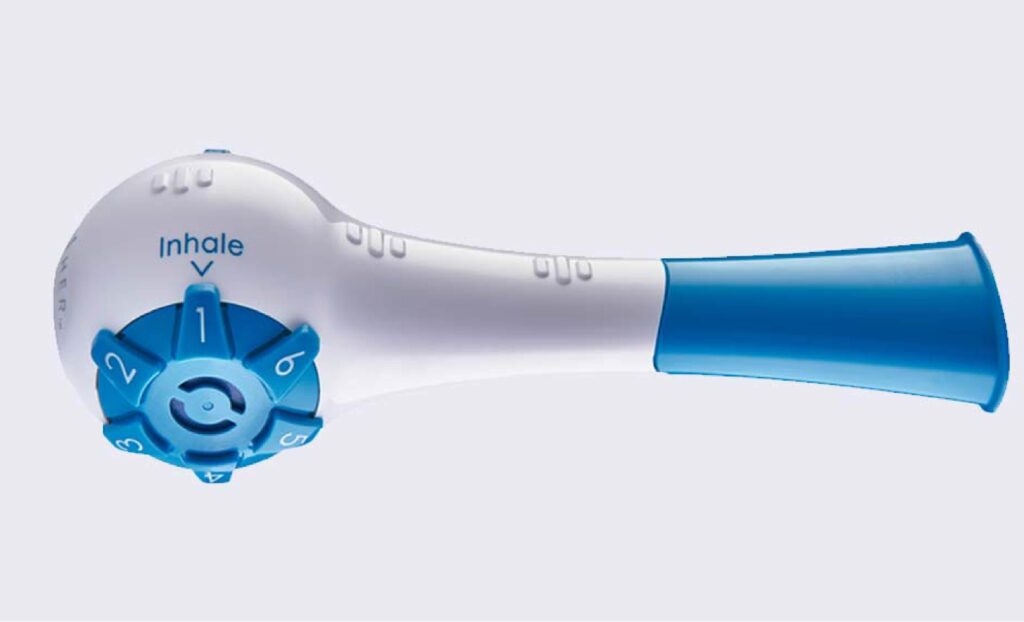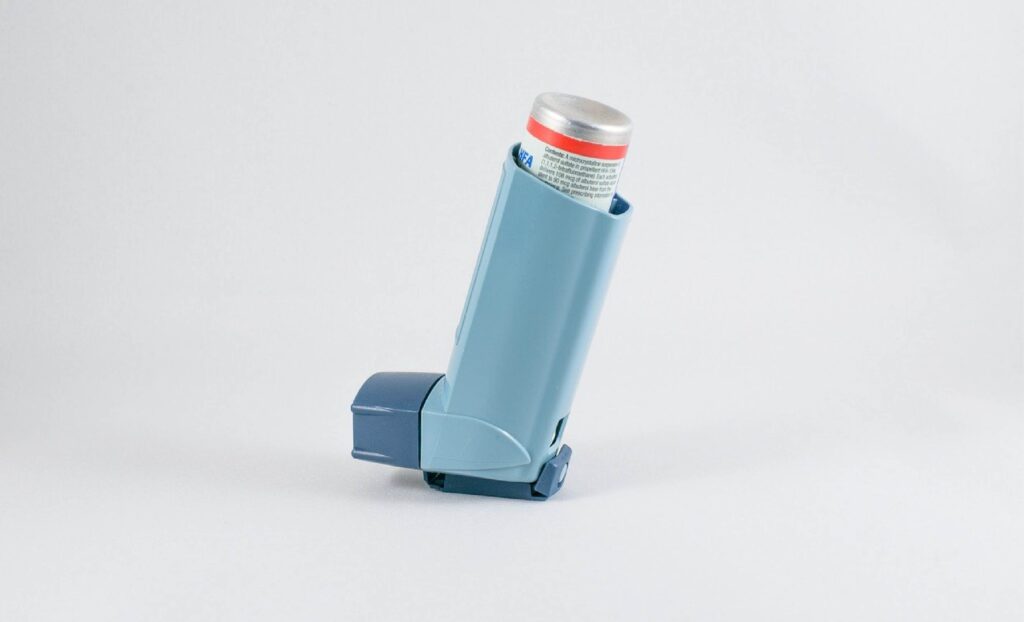Many unfortunate events can put the human body in compromised health. Diseases like COPD, CHF, Dysphagia, Stroke, and hypertension can reduce the ability to breathe in enough oxygen for the body to function at its best. Prescription drugs sometimes help, but we have a better, drug-free solution. The Breather. The Breather is a simple-looking device that claims to be the world’s first drug-free respiratory muscle training device. But should you use the breather respiratory muscle trainer? Here is our review of the Breather.
The Breather Respiratory Muscle Trainer

The Breather is the world’s first drug-free respiratory muscle training device. It was first invented in 1980 by Peggy Nicholson and was prescribed to more than a million patients.
In this post, we’ll review the newer model of the Breather, which is known by the same name.
The new Breather follows in the footsteps of the original, with some significantly improved dynamics for today’s patients. The newer model is designed for patients of all ages, from age 4 to 94. It now has two independent dials for controlling intake and outtake. The mouthpiece is also improved, and now it comes with a 15-millimeter to 22-millimeter adapter.
The quality of the new breather is significantly improved with evidence-based results.
When should I use The Breather Respiratory Muscle Trainer?

When should you use The Breather Respiratory Muscle Trainer? Anytime you want to improve your quality of life. The breather is a respiratory muscle trainer; therefore, it improves your breathing and other related metabolic and physical functions. Can it improve your overall quality of life? Certainly yes.
Breathing is so intricately tied to all the of functions in the body. For example, the amount of oxygen in your blood depends on your lungs and breathing. The more oxygen you have in your blood, the more active and vital you feel.
The Breather Respiratory Muscle Trainer User Guide
The breather is a device for respiratory muscle training. You should know how to use it properly before buying it. So here is a short guide on how you can use the breather for respiratory muscle training.
The breather has two dials and one swappable mouthpiece. The primary mouthpiece is scientifically designed for you to grip with your lips and have enough mouth space for breathing. (Do not bite the mouthpiece with your teeth, it can cause pain in the jaw.)
The secondary mouthpiece is a 15-millimeter to 22-millimeter adapter which will easily connect with any medical tube that is required. You will inhale and exhale air with this mouthpiece.
Now, look at the dials of the Breather. There are two independent dials. One is the inhale dial and the other is the exhale dial.
The inhale dial has six settings from 1 to 6. 1 is the easiest and 6 is the hardest level for air inhalation through the Breather.
On the exhale dial, we have 5 settings from 1 to 5. As both dials are rotatable separately, you can set them in different combinations to make different challenging scenarios for yourself.
It’s better to ask your doctor who prescribed you the Breather about how you should set the dials and how often you should use the Breather.
One more thing to keep in mind: It’s a good idea to take notes of how you are feeling before and after using the Breather. These notes will provide you instant feedback on your progress.
Also, it is recommended that you wash your Breather once a week or even more regularly if you prefer.
To wash the breather, detach the mouthpiece and wash it in room temperature water with mild soap. Shake out all the excess water inside and air dry the Breather.
Warning, do not wash the Breather in the dishwasher, do not use warm water, and do not use heat to dry it. The rubber diaphragm will get damaged if you do, and it will also void the warranty.
The Benefits of The Breather Respiratory Muscle Trainer
There are a lot of benefits of using the Breather for respiratory muscle training. Here are the main benefits of using the Breather.
1. Strengthens the respiratory muscles

The inhale and exhale dials on the breather create different levels of resistance for inhaling and exhaling air into the lungs. This allows the respiratory muscles to work more to supply air to the lungs.
It encourages diaphragmatic breathing and strengthens all the inhaling and exhaling muscles. This makes it one of the best breathing trainers for athletes.
2. Improved laryngeal function for speech and swallowing
The Breather also works on the muscles around your neck area. This allows your larynx to be more active and helps you in speech and safe swallowing of food and water.
3. Improved ability to inhale medication

As your diaphragm muscles strengthen for respiration, this will allow you to better inhale medications that the doctors prescribe for you.
When you have increased your ability to breathe deeply, you will have increased your ability to intake and absorb inhalable medications.
4. Reduce hypertension

Setting the Breather’s inhale dial to a higher difficulty level will promote slow breathing. Slow breathing will activate your parasympathetic nervous system.
This will decrease your heart rate and reduce overall blood pressure. Your brain will associate it with relaxation. This leads to lowering your risk of hypertension.
5. Improve oxygen saturation in blood and blood flow
The Breather will improve your breathing, and that will result in more oxygen flowing in your blood. This may also improve circulation.
6. Decrease shortness of breath
Regularly exercising with the Breather will help your lungs automate the breathing process at its primal level. This will prevent shortness of breath. Therefore, you will not have a lack of oxygen in your blood, your blood will flow smoothly throughout your body, and you won’t have to worry about hypertension.
Comparison Table
Here we have compared the Breather with another best breath trainer, the EMST 150. As you will see, the Breather is superior in that it does not require calibration, it has both inhale and exhale controls, and it does not require an uncomfortable nose clip.
| The Breather | EMST 150 | |
| Calibration | No | Yes |
| Inhale control | Yes | No |
| Exhale control | Yes | Yes |
| Nose clip | No | Yes |
FAQ
- How many times a day should I use my Breather?
That depends on your doctor’s prescription. Some may need to use it once in the morning, while others may need to use it three times a day. Your doctor will prescribe you accordingly with your medical condition.
- How often should I wash my Breather?
We would recommend you to wash the Breather once a week. But you can wash it more often if you want.
But do not wash it with warm water, or not in the dishwasher. The heat will damage the diaphragm and the warranty will not cover that type of damage.
- What Is the Diaphragmatic Breathing Technique?
The diaphragmatic breathing technique involves your diaphragm only. All your other muscles such as the chest muscle should remain neutral in this breathing technique.
This technique strengthens your diaphragm, as well as your larynx.
Conclusion
So that was our review of the Breather. Do we recommend it? Definitely yes. The Breather is a great device for respiratory muscle training. Ask your doctor about getting a Breather for better health and well being.
You can also read: Breath Watching: All You Need to Know